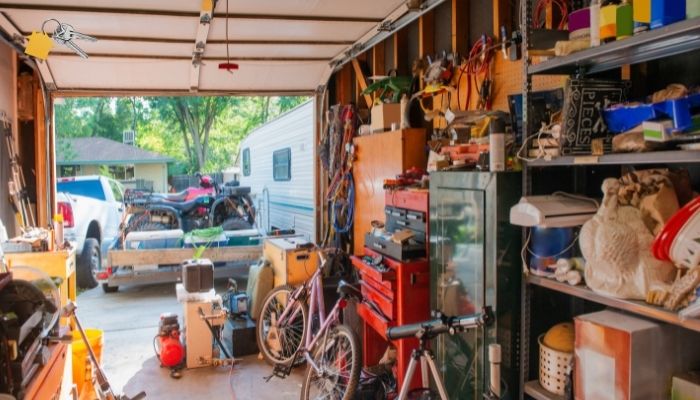Rare books
Paperback novels, technical manuals, and office supply catalogs may not be worth much to you. But if you’re one of the many people who still cherish book collecting as a hobby, then you’ll want to take proper care of your first editions, limited editions, and other rare books. If properly maintained in climate-controlled storage, these valuable books can appreciate in value by several hundred dollars or more.
Rare books can lose some of their value if they are improperly stored in an area that is too hot or too cold. The same goes for keeping them in an environment where the humidity is too high or too low. High humidity levels are especially detrimental to paperbound books because it encourages mold growth, which can damage or destroy pages. Low humidity can make pages brittle and susceptible to cracking, tearing or crumbling. Dust buildup can also affect rare books and their market value

Rust-prone tools
If you are storing tools made of iron or steel, they will benefit from being kept in a climate-controlled unit. This is because humidity causes rust to form on metal tools; similarly, temperature fluctuations can cause wood handles to shrink or crack.
Musical instruments
Wooden instruments, such as pianos and guitars, can warp or crack. String instruments can lose their pitch, while metal instruments can rust. Paintings and sculptures can fade or lose color if they are not stored in a climate-controlled environment.
Furniture
The sun can be a destructive force on your furniture pieces. If you are storing your furniture in a self-storage unit, make sure it is not placed next to a window or any other source of direct sunlight at any point during the day. This will prevent fading and/or damage due to the sun’s rays.
Old maps and documents
Old maps and documents are often dry and brittle, so humidity can be especially damaging to them. Climate-controlled storage is ideal for these items because it keeps the temperature and moisture control. This will help preserve their integrity and keep your old maps in good condition.
Any type of artwork
“You can never be too careful with your artwork. Even if you have a piece that survived through some historical upheaval, you still need to treat it with respect. Artworks may be made from durable materials like wood, metal, and plastic, but they are still susceptible to the elements such as humidity and temperature fluctuations. If you have a storage space that’s not climate-controlled, then make sure you don’t keep your artwork there for too long.”
High-quality clothing you don’t wear regularly
- High-quality clothing you don’t wear regularly
Need to get your tuxedo looking sharp for the gala in a month? With climate-controlled storage, you can rest easy knowing that when you take it out of storage, it’ll be pristine. If your best clothes are sitting in your closet and collecting dust, free up some space by putting them somewhere safe.
- Anything made of fur or leather
You need to store these items properly if you want to preserve their value. We recommend using professional cleaners because they have experience with the intricacies of leather and fur care (and not just because we own a dry cleaning business). Furs especially are very vulnerable to damage from prolonged exposure to heat, cold, and moisture—all things that climate-controlled storage prevents.
Photo albums and other collections
Photo albums and other collections
If you have a photo album collecting dust on your shelf, or you’ve been meaning to sort through the boxes of photographs in your attic, climate-controlled storage is a great option. The paper used to print photographs can easily yellow or degrade. Additionally, moisture can cause mold and heat, and cold can be damaging. Photographs are best stored in a cool, dry environment with low humidity and moderate temperature fluctuations. Climate-controlled storage units are designed with these specifications in mind and are ideal for storing photo albums, documents, or any other collectibles.
Antique electronics that are rare or have sentimental value
If you own antique electronics that are rare or have sentimental value, you will want to store them in a climate-controlled storage unit. Due to the delicate nature of these items, storing them in a facility with unregulated temperatures can cause damage.
These items can be susceptible to condensation as well as direct exposure to water and other elements. You’ll also need to consider factors like high heat or cold that could potentially damage circuitry or wires, causing the item(s) to fail entirely.
Long-term storage involves an increased risk of rusting or corrosion on valuable metals (copper, aluminum). Use dehumidifiers if possible and also make sure there is space between each electronic item for air circulation.
Antique furniture or period pieces that are regularly on display in your home
- Antiques. Furniture and other items that you deem to be antiques in your home likely need climate control. If you want to keep them looking their best, it’s important to maintain the same temperatures and humidity levels that they are used to. This means that storing them in a place where the temperature or humidity swings too much will not be ideal for keeping them at the quality level you desire.
- Period pieces on display in your home. If you have period furniture or art in your home and it is on regular display, this means that it is likely exposed to fluctuations in temperature and humidity levels all year long. In order to help protect these items from wear and tear, consider storing them inside of a climate-controlled unit when they aren’t on display so that they can maintain the same levels of temperature and humidity throughout the year.
Wine collections
- If you are looking to invest long-term in your wine collection, climate-controlled storage is a must. Wines need to be stored at a constant temperature, preferably between 55 and 57 degrees. This is because the heat and humidity can cause the wine to expand, pushing air through the cork. Exposure to air will eventually cause oxidation and spoilage of the wine.
- Wine collections also need to be stored horizontally so that the cork stays moist. If it dries out, it may shrink, allowing air into the bottle and spoiling the wine. Also make sure your bottles are kept away from strong odors that could permeate through the cork like gasoline, tobacco smoke or paint fumes—all of these will affect your wine’s taste over time.
- Lastly, make sure you store your collection away from heat sources or direct sunlight as both of these can damage your wines. Some people like having their collections in a cellar-style atmosphere with dark walls covered in wooden racks but this is not mandatory for climate control purposes; some modern storage facilities keep your bottles in racks within a room filled with shelves just like any other warehouse space!
Memorabilia, such as sporting equipment, trophies, or even yearbooks or other collectibles such as bobbleheads, posters, and cards.
Climate-controlled storage is necessary for storing memorabilia. Memorabilia may include sports equipment, trophies and awards, military uniforms or flags, yearbooks, and other collectibles such as bobbleheads, posters or cards.
To protect your items from any climate changes that may occur during the year, you’ll want to find an indoor unit that offers climate control. These units stay within a temperature range of about 55°F – 85°F (13°C – 29°C) throughout the year. This will help prevent items from major temperature fluctuations in both directions—extreme heat can damage paper and photographs while extreme cold can cause condensation and mold growth.
You should also consider purchasing a dehumidifier to help keep moisture levels low in your unit.
Collections such as model cars, toy trains, and dolls that are fragile or require delicate packaging to prevent damage during storage.
It’s a good idea to keep model cars, toy trains, and dolls that are fragile or require delicate packaging in a climate-controlled storage unit. Those items will remain in great shape when stored at a temperature that is not too hot or too cold, and they won’t be affected by moisture in the air. The same can be said for other collectibles like baseball cards, comic books, vinyl records, sports memorabilia, and art prints – they all need to be protected from extreme temperatures.
If you have any of these items at home that you want to keep safe year-round, consider investing in climate control with your storage solution.
These items need special storage conditions.
It’s a common misconception that climate-controlled storage is only needed to protect items sensitive to temperature extremes. However, the optimal conditions for keeping certain objects in good shape are actually quite complex. Many of these conditions can be met by climate-controlled storage units. Deciding which items need this kind of special care can be tricky, so here are six things to keep in mind:
- Temperature: Specialty items that react negatively to high or low temperatures may require climate control. The same goes for wooden furniture and instruments, which could expand or contract if humidity levels aren’t stable; you’ll want to store them indoors away from moisture and large temperature swings.
- Dust: Some objects may also need protection from dust and other airborne contaminants, including electronics like computers and cameras. This is especially true if they have any openings into internal components through which debris can easily accumulate. (Transmission problems may occur as a result.) Jewelry boxes with felt interiors should be stored similarly since their contents could get scratched by dust particles over time.
- Pests: Not only do rodents make unwelcome guests, but they also gnaw through wood and cardboard packaging materials in search of food sources—and often leave behind feces as proof of their visit! Climate-controlled storage units reduce your risk of attracting pests by protecting your belongings from moisture damage while also keeping them at an appropriate temperature range for human comfort; this means critters will be less attracted to your unit than one kept outdoors where it’s hot all year long.
- Air Circulation: Limited air circulation can cause mold growth on certain fabrics such as wool blankets or leather furniture (which absorb moisture), so those objects should always be kept dry with adequate ventilation—even when stored indoors! As long as these items stay clean and dry inside an airtight baggie made out of breathable material (like cotton). You’re good to go!




